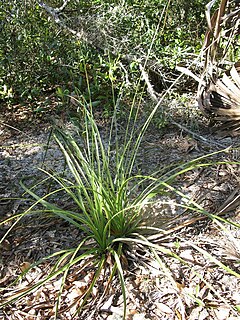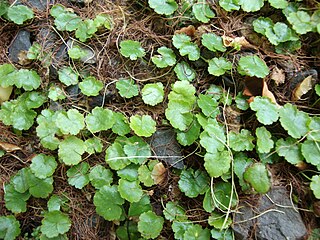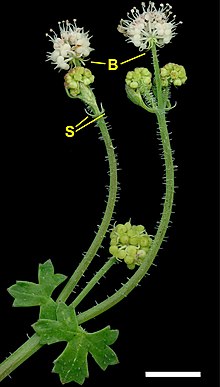Persoonia micranthera, commonly known as the small-flowered snottygobble, is a species of flowering plant in the family Proteaceae and is endemic to a restricted area in the south-west of Western Australia. It is a low-lying to prostrate shrub with branchlets that are hairy when young, spatula-shaped to lance-shaped leaves with the narrower end towards the base, hairy yellow flowers borne in groups of four to fifteen, and smooth, oval fruit.

Hydrocotyle, also called floating pennywort, water pennywort, Indian pennywort, dollar weed, marsh penny, thick-leaved pennywort and even white rot is a genus of prostrate, perennial aquatic or semi-aquatic plants formerly classified in the family Apiaceae, now in the family Araliaceae.

Hydrocotyle vulgaris, the marsh pennywort, common pennywort, water naval, money plant, lucky plant or copper coin, is a small creeping aquatic perennial plant native to North Africa, Europe, the Caucasus and parts of the Levant.

Nolina brittoniana is a rare species of flowering plant in the asparagus family known by the common name Britton's beargrass. It is endemic to Florida, where there are 72 known populations, only a few of which are large enough to be considered viable. It is federally listed as an endangered species of the United States.

Persoonia glaucescens, commonly known as the Mittagong geebung, is a species of flowering plant in the family Proteaceae and is endemic to New South Wales. It is an erect shrub with smooth bark, hairy young branchlets, lance-shaped leaves with the narrower end towards the base, and yellow flowers. It is the only persoonia in eastern Australia with strongly glaucous leaves.
Persoonia pentasticha is a species of flowering plant in the family Proteaceae and is endemic to the south-west of Western Australia. It is an erect, spreading shrub with hairy young branchlets, linear leaves with five narrow, longitudinal grooves, and hairy yellow flowers borne in groups of up to fifteen on a rachis up to 45 mm (1.8 in) long.
Persoonia papillosa is a species of flowering plant in the family Proteaceae and is endemic to a restricted area in the west of Western Australia. It is a small, erect shrub with hairy young branchlets, linear leaves with six prominent parallel veins, and hairy flowers borne in groups of up to twenty on a rachis up to 60 mm (2.4 in) long.

Eucalyptus effusa, commonly known as rough-barked gimlet, is a species of mallee or small tree that is endemic to Western Australia. It has thin, rough bark on the base of the trunk, smooth bark above, linear to narrow lance-shaped adult leaves, flower buds arranged in groups of seven, white flowers and cup-shaped to conical fruit.
Eucalyptus kenneallyi, commonly known as Kenneally's white gum, is a species of tree that is endemic to two small islands off the Kimberley coast of Western Australia. It has smooth bark, lance-shaped adult leaves, flower buds in groups of seven, white flowers and cylindrical fruit.
Eucalyptus luculenta is a species of mallee that is endemic to a small area on the south coast of Western Australia. It has smooth bark, lance-shaped to egg-shaped leaves, flower buds in groups of seven, pale yellow to white flowers and cup-shaped, barrel-shaped or cylindrical fruit.
Eucalyptus recta, commonly known as silver mallet, is a species of mallet or tree that is endemic to a small area in Western Australia. It has smooth silvery bark, lance-shaped adult leaves, flower buds in groups of nine or eleven, creamy white to pale yellow flowers and pendent, flattened spherical fruit.

Corymbia cadophora, commonly known as the twinleaf bloodwood, is a species of small, straggly tree that is endemic to the Kimberley region of Western Australia. It has rough bark on the trunk and branches, a crown of sessile, egg-shaped or lance-shaped leaves joined in opposite pairs, flower buds mostly arranged in groups of seven, creamy white to pink or red flowers and urn-shaped to barrel-shaped fruit.
Corymbia paractia, commonly known as the Cable Beach ghost gum, is a species of low-growing tree that is endemic to the Kimberley region of Western Australia. It has smooth white to pale grey bark, sometimes with rough bark near the base of the trunk, lance-shaped adult leaves, flower buds in groups of three or seven, creamy white flowers and cup-shaped, barrel-shaped or cylindrical fruit.

Hydrocotyle sibthorpioides is a small plant native to southeastern Asia. It is also referred to as lawn marshpennywort. It is a dicot, traditionally placed in the family Apiaceae, but more recently suggested to belong in the Araliaceae. It grows in abundance when the conditions are right. Hydrocotyle sibthorpioides originated in southeastern Asia, but is slowly spreading in the United States, along with other places around the world. It can grow in a wide variety of habitats. It has been used for medicinal purposes in Asia and is also common in the aquarium trade.

Eucalyptus ceracea also known as the Seppelt Range gum or Seppelt Range yellow-jacket, is a species of small tree or mallee that is endemic to a small area in the north of Western Australia. It has thick, fibrous or flaky bark on the trunk and larger branches, dull, glaucous, egg-shaped leaves arranged in opposite pairs, flower buds in groups of seven or nine, bright orange flowers and urn-shaped fruit. The leaves, buds and fruit are covered with a white wax.
Eucalyptus costuligera is a species of small tree that is endemic to the Kimberley region of Western Australia. It has short-fibrous or flaky bark on the trunk and branches, bluish, lance-shaped adult leaves, club-shaped flower buds in branched or unbranched inflorescences with the buds in groups of up to seven, creamy-white flowers and conical, cup-shaped or pear-shaped fruit.
Leptospermum macgillivrayi is a species of small, widely-branching shrub that is endemic to Western Australia. It has hard, knobbly bark, broadly egg-shaped leaves, flowers arranged singly on short side shoots and small fruit that fall from the plant at maturity. It is only known from two locations in the inland of the state.

Goodenia berringbinensis is a species of flowering plant in the family Goodeniaceae and is endemic to Western Australia. It is an annual herb with lance-shaped leaves mostly at the base of the plant, and loose thyrses of yellow flowers.
Goodenia lyrata is a species of flowering plant in the family Goodeniaceae and is endemic to inland areas of Western Australia. It is a prostrate herb with densely hairy, lyrate leaves at the base of the plant, smaller leaves on the stem and racemes of yellow flowers.
Goodenia wilunensis is a species of flowering plant in the family Goodeniaceae and is endemic to central regions of Western Australia. It is an ascending to prostrate annual herb covered with silky hairs and has elliptic to egg-shaped leaves with the narrower end towards the base, and racemes of yellow flowers with purplish markings.











